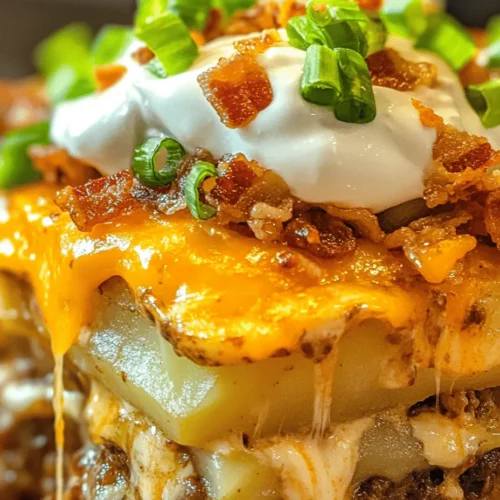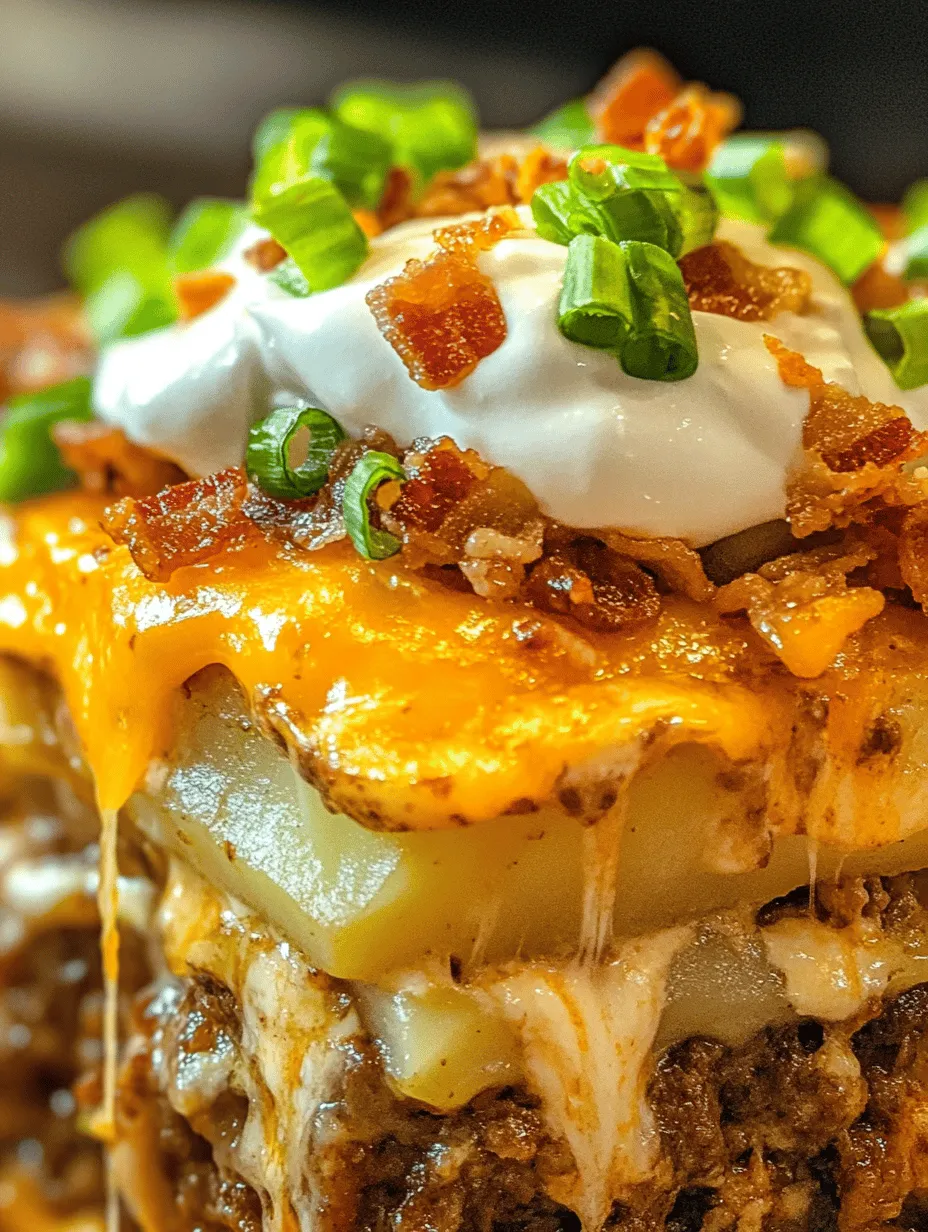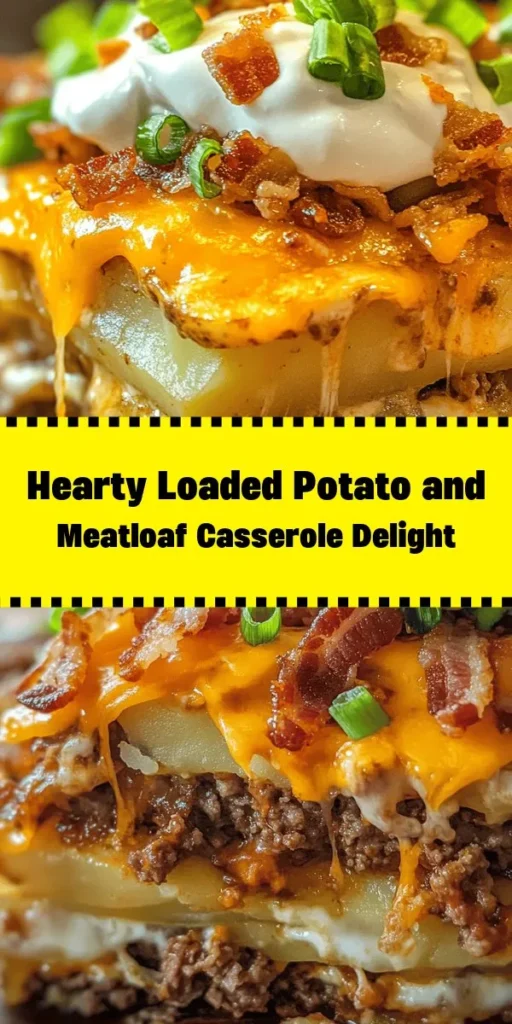Introduction
When it comes to comfort food, few dishes can evoke the same feelings of warmth and satisfaction as a hearty casserole. Casseroles are a staple in many households, cherished for their ability to bring family and friends together around the dinner table. They offer a unique blend of flavors and textures, making them appealing to both children and adults alike. Among the myriad of casserole options, the Loaded Potato and Meatloaf Casserole stands out as a perfect family meal that combines the rich, savory tastes of meatloaf with the creamy, comforting essence of loaded baked potatoes.
Imagine succulent ground beef seasoned to perfection, nestled between layers of fluffy potatoes, melted cheese, crispy bacon, and a hint of fresh green onions. This dish not only satisfies hunger but also delivers a delightful experience for the taste buds. It’s a meal that feels like a warm hug on a cold day, making it ideal for family gatherings, potlucks, or a simple weeknight dinner.
Understanding the Key Ingredients
To create the perfect Loaded Potato and Meatloaf Casserole, it’s essential to understand the role each ingredient plays in the overall flavor and texture of the dish. Let’s take a closer look at the star players that make this casserole a beloved comfort food.
Ground Beef: Choosing the Right Cut for Flavor and Texture
Ground beef serves as the backbone of our meatloaf, providing the necessary protein and heartiness that makes this dish satisfying. When selecting ground beef, aim for a blend that has a fat content of around 80/20 (lean to fat ratio). This balance ensures that the meatloaf remains juicy and flavorful without being overly greasy. Cuts like chuck or sirloin are excellent choices, as they provide a rich flavor profile while maintaining a tender texture when cooked.
The Role of Onions and Garlic: Enhancing Flavor Profiles
Onions and garlic are essential aromatics that elevate the flavor of the meatloaf mixture. Onions add a subtle sweetness and depth, while garlic infuses the dish with a robust, savory note. For the best results, finely chop the onions and mince the garlic, allowing them to meld seamlessly into the meat mixture. Sautéing them until translucent before adding to the meatloaf helps to bring out their natural sweetness and ensures a well-rounded flavor.
The Importance of Breadcrumbs in Meatloaf for Texture
Breadcrumbs play a crucial role in the texture of meatloaf, acting as a binding agent that helps hold everything together while providing a pleasant mouthfeel. They absorb moisture from the meat and other ingredients, ensuring that the meatloaf remains tender and juicy. Using plain or seasoned breadcrumbs will work well, but for an extra layer of flavor, consider using Italian-seasoned breadcrumbs to infuse the dish with herbs and spices.
Overview of Potatoes: Types and Why Russet is Preferred for Casseroles
When it comes to the potato component of the Loaded Potato and Meatloaf Casserole, russet potatoes are often the preferred choice. Their starchy consistency makes them perfect for mashing and layering, creating a fluffy texture that complements the rich meatloaf. Russets also hold their shape well during baking, resulting in a casserole that boasts both creaminess and substance.
Cheese Varieties: Why Cheddar Cheese Complements This Dish
Cheese is an integral part of any loaded potato dish, and for this casserole, sharp cheddar cheese is the star. Its bold flavor contrasts beautifully with the savory meat and creamy potatoes. Additionally, cheddar melts well, creating a gooey, indulgent topping that enhances the overall experience. For a twist, consider mixing in some pepper jack cheese for a touch of heat or using a blend of cheeses for added complexity.
The Significance of Sour Cream and Milk in Creating a Creamy Topping
To achieve the desired creamy topping for the casserole, both sour cream and milk are essential. Sour cream contributes a tangy richness that complements the meat and potatoes, while milk adds the necessary creaminess for a luscious texture. This combination not only enhances the flavor but also helps to keep the casserole moist during baking.
Role of Bacon: Adding Richness and Umami Flavor
Bacon is the finishing touch that takes this casserole to the next level. Its crispy texture and smoky flavor provide an irresistible contrast to the soft potatoes and savory meatloaf. Chop the bacon into small pieces and cook until crispy, allowing the rendered fat to infuse the dish with an umami richness. The addition of bacon not only enhances the flavor but also adds a delightful crunch that elevates the entire casserole.
Green Onions as a Garnish: Adding Freshness and Color
To add a pop of color and a hint of freshness to the Loaded Potato and Meatloaf Casserole, green onions make the perfect garnish. Their mild onion flavor and vibrant green color provide a beautiful contrast to the rich, hearty ingredients. Sprinkle chopped green onions over the finished casserole just before serving to brighten the dish and add a refreshing note.
Step-by-Step Instructions
Now that we have a clear understanding of the key ingredients that make this casserole a standout, it’s time to dive into the step-by-step instructions for preparing the Loaded Potato and Meatloaf Casserole.
Preparing for Cooking: Prepping the Kitchen and Necessary Tools
Before you begin cooking, it’s essential to prepare your kitchen and gather the necessary tools and equipment. Make sure you have the following:
– A large mixing bowl for the meatloaf mixture
– A knife and cutting board for chopping vegetables
– A skillet for sautéing onions and garlic
– A casserole dish (approximately 9×13 inches) for baking
– A potato peeler for peeling the potatoes
– A masher or mixer for mashing the potatoes
– Measuring cups and spoons for accurate ingredient quantities
Once you have your tools ready, preheat your oven to 350°F (175°C). The importance of preheating cannot be overstated, as it ensures even cooking and allows the casserole to develop a beautiful golden-brown crust.
Creating the Meatloaf Mixture: Techniques for Mixing Without Overworking
In a large mixing bowl, combine the ground beef, sautéed onions and garlic, breadcrumbs, salt, pepper, and any additional seasonings you desire. Gently mix the ingredients using your hands or a fork until they are just combined. Be careful not to overwork the meat, as this can lead to a dense texture. Form the mixture into a loaf shape and set it aside while you prepare the potato layer.
Layering the Casserole: Tips on Achieving Even Layers for Perfect Cooking
To prepare the potato layer, peel and dice the russet potatoes into small chunks. Place them in a pot of salted water and bring to a boil. Cook until the potatoes are fork-tender, approximately 15-20 minutes. Drain and return the potatoes to the pot, adding sour cream and milk. Mash the potatoes until smooth and creamy, then season with salt and pepper to taste.
Now it’s time to layer the casserole. Start by spreading half of the mashed potatoes evenly across the bottom of your greased casserole dish. Next, place the meatloaf mixture on top, pressing it gently to ensure an even layer. Finally, spread the remaining mashed potatoes over the meatloaf, smoothing the top with a spatula.
Once your layers are assembled, it’s time to add the finishing touches. Sprinkle the shredded cheddar cheese evenly over the top, followed by the cooked bacon pieces. This layering technique not only enhances the flavor but also ensures that each bite is packed with all the delicious elements of the casserole.
By following these initial steps, you are well on your way to creating the ultimate Loaded Potato and Meatloaf Casserole that will surely become a family favorite. Stay tuned for the next part, where we will dive deeper into the baking process and share tips for serving this delightful dish.

Crafting the Creamy Topping
To achieve the perfect creamy topping for your Loaded Potato and Meatloaf Casserole, begin by combining sour cream and milk in a mixing bowl. The goal here is to ensure a smooth and velvety consistency that will complement the hearty layers beneath. Start with 1 cup of sour cream and gradually add about ½ cup of milk, whisking continuously until you reach a creamy texture. This mixture not only adds richness but also balances the savory flavors of the meatloaf and potatoes.
For an extra kick, consider mixing in a teaspoon of garlic powder or a pinch of paprika to the sour cream mixture. These subtle enhancements will elevate the overall flavor profile of the casserole. Once your creamy topping is ready, set it aside while you prepare the casserole for baking.
Adding Toppings
The toppings are where you can truly personalize your Loaded Potato and Meatloaf Casserole. When it comes to cheese and bacon, distribution is key. For the cheese, shred about 1 to 1.5 cups of your choice – cheddar is a classic, but you can mix in mozzarella for added stretch or pepper jack for a bit of heat.
Once the casserole is assembled, drizzle your creamy topping evenly across the surface. Then, sprinkle the shredded cheese generously over the top. Make sure to cover every inch of the surface, as this will create a deliciously gooey layer when baked.
Next, for the bacon, you can either cook it until crispy and crumble it on top or use pre-cooked bacon bits for convenience. Distribute them evenly to ensure that every bite has a satisfying crunch. The combination of melted cheese and crispy bacon not only enhances the flavor but also adds a delightful texture contrast.
Baking Process
Baking your casserole is a crucial step in developing the right texture. Preheat your oven to 350°F (175°C). Start by covering the casserole dish with aluminum foil. This will trap steam and moisture, allowing the ingredients to cook evenly without drying out. Bake covered for about 30 minutes, then remove the foil and continue baking for an additional 15 to 20 minutes. This uncovered baking time is essential for achieving a beautifully golden and bubbly cheese topping.
Keep an eye on the casserole to ensure it doesn’t over-brown. The edges should be crispy, while the center remains soft and creamy. Once it’s ready, remove it from the oven and let it rest for about 10 minutes before serving. This cooling period allows the layers to set, making it easier to cut and serve.
Cool Down and Garnishing
After allowing the casserole to cool for a few minutes, it’s time to elevate its presentation. You can garnish the dish with freshly chopped chives or parsley, which adds a pop of color and freshness. Not only does this enhance the visual appeal, but it also adds a subtle herbal note that brightens the deep flavors of the casserole.
Consider serving with a dollop of additional sour cream on the side for those who love an extra creamy element with their meal. Place this on the dinner table alongside the casserole, allowing guests to customize their plates.
Nutritional Analysis
Understanding the nutritional content of your Loaded Potato and Meatloaf Casserole can help you enjoy it guilt-free. On average, a serving (about one cup) contains approximately:
– Calories: 400-500
– Protein: 25-30 grams
– Fats: 20-25 grams
– Carbohydrates: 35-45 grams
This breakdown highlights the dish’s filling nature, thanks primarily to the meat and potatoes. Both ingredients are rich in protein and carbohydrates, making this casserole a hearty meal option.
Nutritional Benefits
The potatoes in this dish provide essential vitamins and minerals such as vitamin C, vitamin B6, and potassium, while the lean ground meat contributes a significant protein boost. If you opt for lean ground beef or turkey, you can reduce the overall fat content without sacrificing flavor.
For a healthier twist, consider substituting half of the sour cream with Greek yogurt. This swap not only cuts calories but also adds probiotics for gut health. Additionally, using reduced-fat cheese or adding more vegetables like spinach or bell peppers can enhance the nutritional profile without compromising taste.
Serving Suggestions
Pairing your Loaded Potato and Meatloaf Casserole with the right sides can elevate the meal. A fresh green salad dressed with a light vinaigrette complements the richness of the casserole beautifully. For a heartier option, serve with crusty bread or garlic knots to soak up any extra creaminess.
If you find yourself with leftovers, consider transforming the casserole into new meals. You can repurpose it as a filling for stuffed bell peppers or mixed into a breakfast scramble with eggs. The versatility of this dish means it can easily adapt to whatever you have on hand.
Cultural and Historical Context
Casseroles have long been a staple in home cooking, originating from the French word “casserole,” which means “saucepan.” They gained popularity in American cuisine during the 1950s, becoming synonymous with comfort food. The Loaded Potato and Meatloaf Casserole is a modern take on classic comfort, combining two beloved American dishes: meatloaf and loaded baked potatoes.
The history of meatloaf dates back to the 5th century as a way to stretch meat, while potatoes have been a dietary staple since their introduction to Europe in the 16th century. Together, they represent the evolution of home cooking, where practicality meets comfort, resulting in a dish that not only nourishes but also brings families together around the table.
Conclusion
The Loaded Potato and Meatloaf Casserole embodies the essence of comfort food, combining rich flavors and hearty ingredients into a single dish that is sure to please. Its creamy topping, savory meatloaf, and tender potatoes create a delightful experience for the senses. This recipe is not just about nourishment; it’s about creating memories around the dining table with family and friends.
We encourage you to try this recipe at home and discover the joy of serving a dish that is both satisfying and soul-warming. Whether it’s a weeknight dinner or a gathering with loved ones, this casserole is sure to become a favorite. Embrace the tradition of homemade meals and the happiness they bring, one delicious bite at a time.



